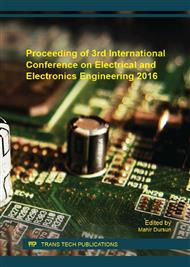[1]
Bibikov, S.B., et al. Application of radioabsorbing materials for the decision of a problem of the radioelectronic equipment compatibility. in Ultrawideband and Ultrashort Impulse Signals, 2004 Second International Workshop. (2004).
DOI: 10.1109/uwbus.2004.1388072
Google Scholar
[2]
Hasnain, A., et al. Development of an economic and effective microwave absorber. in Applied Electromagnetics, 2007. APACE 2007. Asia-Pacific Conference on. 2007. IEEE.
DOI: 10.1109/apace.2007.4603966
Google Scholar
[3]
Dash, G. and L. Ampyx, How RF Anechoic Chambers Work. (1999).
Google Scholar
[4]
Shengquan, Z., et al. Design of the anechoic chamber performance measurement system. in Microwave, Antenna, Propagation and EMC Technologies for Wireless Communications (MAPE), 2013 IEEE 5th International Symposium on. (2013).
DOI: 10.1109/mape.2013.6689908
Google Scholar
[5]
Cheldavi, A. and M. Kamarei. Optimum design of N sheet capactive Jaumann absorber using genetic algorithm. in Antennas and Propagation Society International Symposium, 1997. IEEE., 1997 Digest. (1997).
DOI: 10.1109/aps.1997.625428
Google Scholar
[6]
B. -K. Chung and H. -T. Chuah, M. o.R. a. f. a. i. t. d. o. a. c., " Progress In Electromagnetics Research, Vol. 43, 273-285, 2003, (2003).
Google Scholar
[7]
Anzai, H., et al. The equivalent representation of pyramidal absorbers and its application to the analysis of electromagnetic wave absorber's characteristics. in Electromagnetic Compatibility, 1995. Symposium Record., 1995 IEEE International Symposium on. (1995).
DOI: 10.1109/isemc.1995.523621
Google Scholar
[8]
Ngah, R., et al., Absorbers analysis for anechoic chamber. Jurnal Teknologi Maklumat, 2000. 20(4): pp.46-48.
Google Scholar
[9]
Lee, Y.S., et al. An experimental thickness of microwave absorber effect absorption in Ku-band frequency. in Wireless Technology and Applications (ISWTA), 2013 IEEE Symposium on. (2013).
DOI: 10.1109/iswta.2013.6688764
Google Scholar
[10]
Salleh, M.K.M., et al. Single layer coconut shell-based microwave absorbers. in TENCON 2011 - 2011 IEEE Region 10 Conference. (2011).
DOI: 10.1109/tencon.2011.6129283
Google Scholar
[11]
Ren, Y. -J. and C. -P. Lai, Wideband Antennas for Modern Radar Systems. Radar Technology. (2010).
DOI: 10.5772/7187
Google Scholar
[12]
ETS-Lindgren, RF Microwave Absorbers. (2014).
Google Scholar
[13]
Feng, Y., T. Qiu, and C. Shen, Absorbing properties and structural design of microwave absorbers based on carbonyl iron and barium ferrite. Journal of Magnetism and magnetic materials, 2007. 318(1): pp.8-13.
DOI: 10.1016/j.jmmm.2007.04.012
Google Scholar


